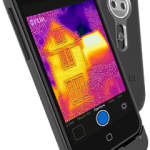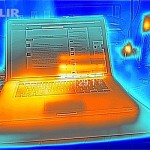Its a good question, and having had a unit in my hands these last 3 weeks, I am split down the middle. As a Thermographer with over 10 years experience of the Thermography industry, I am un-inspired by the unit, but as a closet geek, I love the damn thing! Firstly lets get the physical description over with – as expected
for a Portable Thermal imaging product from FLIR, its black. You get a nice simple jacket that acts as retainer for the actual FLIR ONE module. It all goes together well and feels solid in your hand. The iPhone weighs more than the FLIR ONE and assembled its about twice as thick and 14mm longer, so it still goes in your pocket.
Charging the FLIR ONE is done using a micro-usb connector and when the phone is connected this does NOT charge the phone as well – the Lightning connector does not fit and you can’t download the images using a USB cable – you will need to remove the FLIR ONE and connect the Lightning cable (or sync wirelessly). Apps are available free off the App Store and cover the basic use, Panorama, Close-up, Timelapse and Paint – which are pretty much self evident. To set up the unit is very simple – attach the jacket and the slide on the FLIR ONE, pull the slider down to turn it on and once its booted up (approx 15 secs)it gives a simple thermal image. And thats it. The user gets a choice of palettes and there is an optional centre spot for temperature measurement. For thermography applications there is a very limited choice of 4 emissivity settings (Matte, Semi-matte, Semi-glossy and Glossy), no Tref / Tamb etc options.
The thermal image is from the first manifestation of the new LEPTON™ core and I suspect that this is more its purpose than anything else – it will inspire the OEM market to add Thermal Imaging to a variety of other devices, toys, home automation, automotive applications etc. This version of the LEPTON™ is an 80×60 pixel, 100mK detector, with a 640×480 visual camera for the MSX overlay. Curiously (or perhaps not!), FLIR have also released an Automation version with very simple integration capability – the FLIR AX8 which is a groundbreaking product for the process monitoring and control market.
So what might the future hold? Embedding IR cores into a host of devices will be limited only by the imagination, but in the short term, given FLIR’s focus on Test and Measurement, it is not difficult to imagine a variety of traditional measurement instruments such as Clamp Meters and Multimeters being enhanced with an IR camera, and even video endoscopes now that the size is small.


